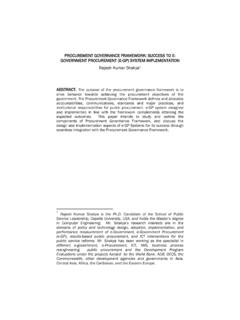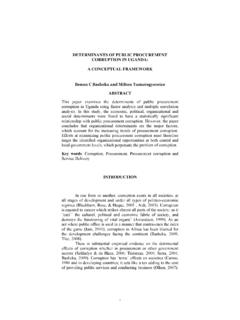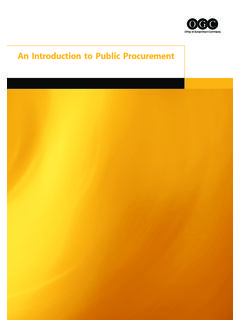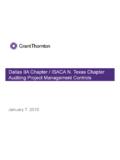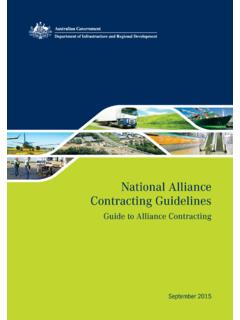Transcription of METHODOLOGY FOR ASSESSING PROCUREMENT
1 METHODOLOGY FOR ASSESSING PROCUREMENT SYSTEMS (MAPS) 20181 FOREWORDP ublic PROCUREMENT is a crucial component of public services delivery, good governance and sustainable economies with inclusive growth. Governments around the world spend approximately USD trillion in public contracts every year. This fact means that on average, public PROCUREMENT constitutes around 12%-20% of a country s The strengthening of public PROCUREMENT systems is thus central for achieving concrete and sustainable results and to build effective METHODOLOGY for ASSESSING PROCUREMENT Systems (MAPS) was initially developed in 2003/2004, thanks to the col-lective efforts of many stakeholders. Its goal was to assess and improve public PROCUREMENT systems by providing a common tool for analysing information on key aspects of any system.
2 MAPS has been widely used to assess the quality and effectiveness of public PROCUREMENT systems and, based on the strengths and weaknesses identified, to develop strategies and implement reforms. These efforts typically focused on creating the foundation for a well-func-tioning public PROCUREMENT system by establishing a legal, regulatory and institutional framework. This revision to the original MAPS reflects a modern understanding of public PROCUREMENT , taking account of global de-velopments and improvements suggested by the wide array of users and stakeholders. The new MAPS is a universal tool that aims to catalyse and accelerate the implementation of modern, efficient, sustainable and more in-clusive public PROCUREMENT systems in all countries. MAPS assessments highlight where reforms are most needed and indicate how reforms can be best carried out.
3 1 12% in OECD countries and 18%-20% in the European Union; this percentage may be higher in some developing FOR ASSESSING PROCUREMENT SYSTEMS (MAPS) MAPS2 The MAPS revision was guided by several considerations: Value for money, reflecting the basic goal that every PROCUREMENT system should be providing the required goods, works and services in an economic, efficient, effective and sustainable way. Transparency, reflecting the basic and commonly agreed-upon principle of disclosure to make policies, legal and institutional frameworks and information related to decisions available to the public in a comprehensible, accessible and timely manner. Fairness, reflecting the ambition that the public PROCUREMENT process should be free from bias, ensure equal treatment and take decisions accordingly, thus ensuring integrity. Good governance, recognising the importance of the wider governance context on the way public procure-ment is conducted and how reforms to PROCUREMENT are implemented.
4 This aspect includes reflection of hori-zontal PROCUREMENT goals, policy considerations and integrity elements have been integrated to ensure that the application of MAPS helps contribute to effec-tiveness. Among those considerations are national policy objectives, including targets on sustainability, support for the private sector, civil service reform, etc., as well as other factors that create an enabling environment for a well-functioning PROCUREMENT system, such as good public financial management, accountability, legal certainty and workforce capacity. The new version of MAPS is timely in the wake of the launch of the Sustainable Development Goals (SDGs). Like the SDGs, MAPS will be relevant for all countries, irrespective of income level or development status. MAPS is related to Goal 12, which calls for the promotion of sustainable PROCUREMENT practices in line with national priorities and policies, and Goal 16, which calls for effective and accountable institutions.
5 In addition, MAPS is anchored in the 2015 Organisation for Economic Co-operation and Development (OECD) Recommendation of the Council on Public Procure-ment and is reflective of leading international PROCUREMENT frameworks such as the United Nations Commission on International Trade Law (UNCITRAL) Model Law on Public PROCUREMENT (2011), the European Union (EU) Directives on Public PROCUREMENT (2014), and the PROCUREMENT frameworks used by multilateral development banks, countries and im-plementing institutions. It provides a holistic assessment framework, establishing the criteria of an effective and efficient PROCUREMENT system that all countries should strive to achieve. The MAPS revision process was a co-operative effort that included countries and partners alike. The draft revised MAPS METHODOLOGY was open to public consultations and was further vetted in a testing and piloting phase involving a diverse set of countries spanning various income categories and development situations, to ensure broad participation and con-tributions from the public and private sector as well as civil OF CONTENTSTABLE OF CONTENTSSECTION I USER S GUIDE.
6 5 Introduction ..5 Assessment Process ..10 Assessment Report ..11 Strategic Planning and Monitoring to Prepare Reforms ..12 Further Information and Support ..13 SECTION II ANALYSIS OF COUNTRY CONTEXT ..15 Objectives and Scope ..15 Structure ..16 Information Sources ..17 SECTION III ASSESSMENT OF PUBLIC PROCUREMENT SYSTEMS ..19 Pillar I. Legal, Regulatory and Policy Framework ..19 Pillar II. Institutional Framework and Management Capacity ..35 Pillar III. Public PROCUREMENT Operations and Market Practices .. 47 Pillar IV. Accountability, Integrity and Transparency of the Public PROCUREMENT System ..53 ANNEXES ..67 Annex 1 MAPS Indicator System ..67 Annex 2 MAPS Assessment Criteria Expressed in Quantitative Terms ..70 GLOSSARY ..76 FOR REFERENCE ..803 MAPS45 SECTION I USER S GUIDE SECTION I USER S GUIDE IntroductionObjective of the User s Guide1.
7 This User s Guide aims to facilitate a consistent approach to the application of the METHODOLOGY for ASSESSING Pro-curement Systems (MAPS), focusing on how the findings can be most effectively translated into and use of the methodology2. MAPS is intended to provide a harmonised tool for use in the assessment of public PROCUREMENT systems. The meth-odology is designed to enable a country, with or without the support of external partners, to conduct an assessment of its PROCUREMENT system in order to determine its strengths and weaknesses. The resulting information can serve as the basis for harmonised system development and reform initiatives2 that can improve capacity and address any weaknesses. The assessment also provides the country with information it can use to monitor the performance of its system and evaluate the success of the reform initiatives in improving performance.
8 By identifying weaknesses in a country s current system, it also offers external partners information that can help them determine risks to the funds they provide to partner countries. 3. MAPS is a universal tool. It aims to lay the foundation for a well-governed public PROCUREMENT system that helps meet policy objectives, increase public trust, enhance well-being and build more prosperous and inclusive societies. It is guided by the principles value for money, transparency, fairness and good governance. The 2017 version of MAPS embodies high aspirational standards and serves as a guide toward reform, rather than setting out minimum stand-ards that countries are universally required to attain. Depending on the conditions in a given country, for example in the case of fragile states that are vulnerable to conflict, these aspirational standards may only be achievable over a longer The MAPS assessment is neither an audit of a PROCUREMENT system, nor intended as a substitute for a fiduciary as-sessment by the country, a donor or other external partners, if required.
9 It aims to provide a common assessment tool for countries and for the international community, irrespective of geographical The terms reform initiatives and system development are used interchangeably in this METHODOLOGY . MAPS6 SECTION I USER S GUIDE Analytical Framework (Overview)Building blocks 5. The MAPS analytical framework consists of a core assessment METHODOLOGY and a number of supplementary mod-ules. 6. The MAPS core METHODOLOGY described in this document provides a comprehensive approach for ASSESSING pro-curement systems. It defines the structure for conducting a country context analysis, presents a refined indicator system for ASSESSING the quality and performance of the system in terms of outcomes and results, and describes the key elements of the assessment process. 7. Supplementary modules are progressively being developed to complement the core assessment METHODOLOGY .
10 They focus on specific policy areas of public PROCUREMENT and can be used by countries depending on their needs. Analysis of country context8. Section II, Analysis of country context , presents a structured approach for analysing the local environment, to ensure that the assessment is anchored in a country s specific needs and that the different elements of the MAPS analytical framework are applied The context analysis draws on easily accessible information and existing data, and focuses on a number of factors essential for PROCUREMENT reform. These include the country s economic situation, its national policy objectives, the public PROCUREMENT reform environment, and the relationship between the public PROCUREMENT system, the public finance management and the public governance systems. The context analysis also identifies key stakeholders for-mally and informally linked to public PROCUREMENT system 10.
